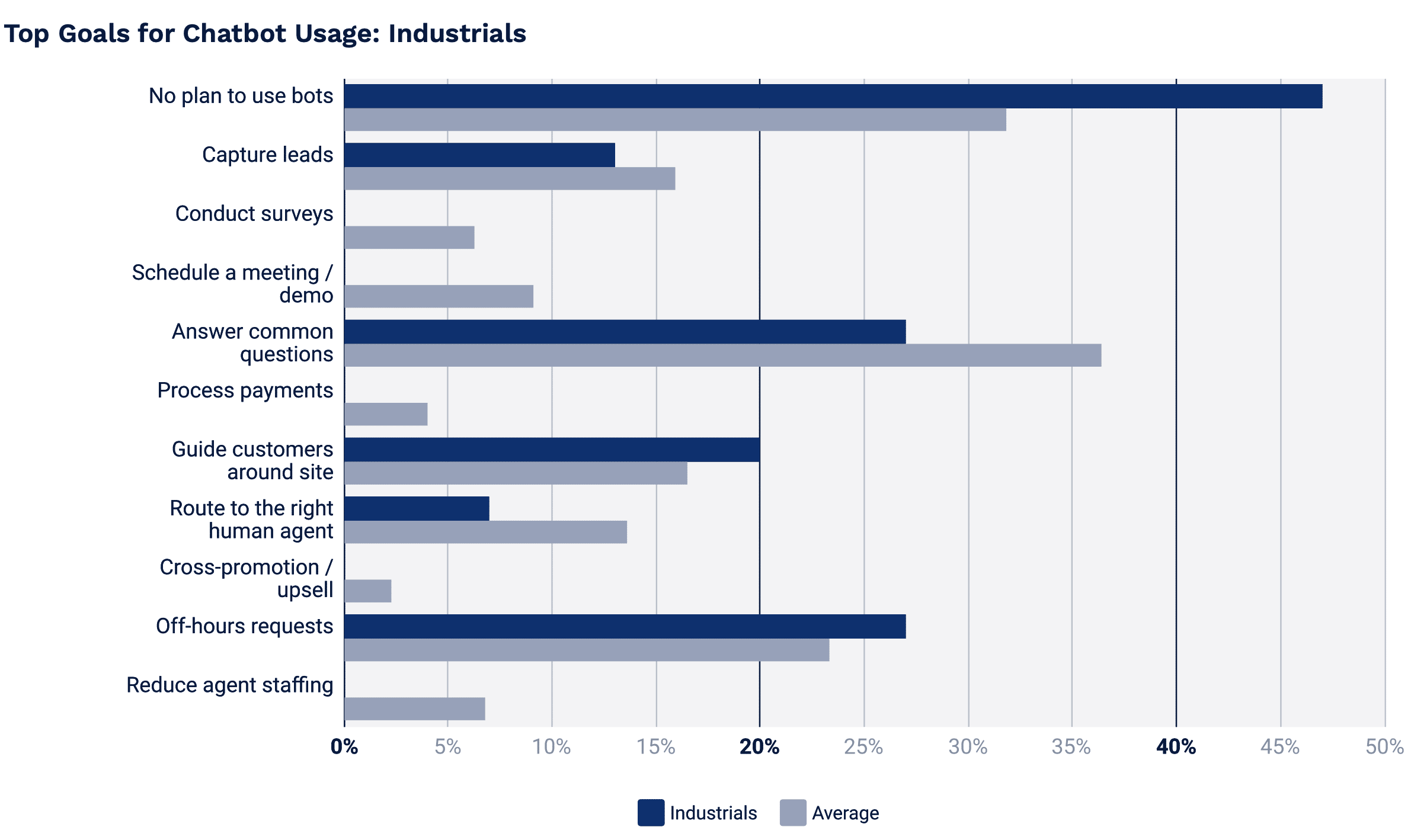
Covid-19 created simultaneous challenges and opportunities for manufacturers. On one hand, the second quarter of 2020 saw an 11.1% drop in global manufacturing output. At the same time though, demand for online goods increased dramatically, leading some large manufacturers to develop their own direct-to-consumer channels. Appliance manufacturers were already seeing a 10.5% year-over-year increase in online demand between 2014 and 2019, versus 1% growth in retail outlets. It’s become incredibly clear that manufacturers grow revenue with live chat and digital automation solutions.
Due to Covid-19, 26% of consumers around the world are now more willing to buy appliances online than they were pre-pandemic. Bain Insights predicts that this accelerated the pace of direct-to-consumer online adoption by 4-5 years.
Large manufacturers maintain thousands of products and manage locations around the world, operating across myriad languages, cultures, and time zones, and have to address a wide variety of customer needs and concerns. The complex and changing nature of global manufacturing doesn’t simply mean that making things is harder than it was in the past. It also makes attracting new customers and delivering great customer experiences much more challenging as well. These changes make it a necessity for manufacturers to grow revenue with live chat.
Manufacturers know a lot about their customers, but most are not using the insights to build online relationships early in the purchasing and onboarding process.
On the marketing and sales side, many manufacturers fail to engage online consumers before, during, and after a purchase. Manufacturers who build relationships early on in the purchasing process will have a greater chance of up-selling and cross-selling in the future.
On the support side, customer requests, questions, and complaints come from all directions across multiple digital channels such as email, chat, social, and messaging. Simply keeping up with the volume and type of requests can tax support teams beyond their limits. It is even more difficult when facilities, teams, and customers are spread across multiple locations and product portfolios seem miles deep.
The sheer breadth and depth of modern manufacturing operations creates communication gaps that challenge sales and product teams to share pertinent customer information and collaborate on up-sell or cross-sell opportunities, identify customer communication trends, proactively take steps to address them, and even identify new market niches. Inability to use the wealth of information gleaned from customer interactions is akin to leaving money on the table.
That’s where the use of live chat and intelligent automation technologies can make an important difference. Here’s a closer look at the communication challenges that manufacturers face and how integrating the right solution for live chat grows revenue for manufacturers and not only improves the customer experience, but helps grow revenue as well.
Live chat use cases in the industrial sector
- Customer service 100%
- Leads and sales 50%
- Customer experience 45%
The ongoing support challenge
One of the main problems that manufacturers face is scale. Many manufacturers still rely on human agents to answer each and every customer request. This less-efficient method of customer service leads to requests getting lost in the shuffle and dismal response times.
At best, customers eventually get the help they need and their frustration is alleviated. At worst, they lose patience and take their business elsewhere.
Manufacturers already intimately understand the connection between service and revenue. In fact, a recent survey revealed that 74% of manufacturing executives think services will be their primary source of profit in the next several years, and 81% of customer service teams say the service they provide has the greatest impact on how their brand is perceived by customers.
To address this important connection, some manufacturers have incorporated live chat into their processes to improve service and support as well as to grow revenue. Of the companies in the industrials sector who do use live chat, 100% use it for customer service, just over 50% use it for leads and sales, and just over 30% use it for the customer experience, according to a recent report.

However, the same report found that over 45% of companies in the industrials sector still have no plans to use other chat technologies like chatbots and automation, even though today’s smart chatbots can speed up customer response times by up to 80% and save up to 30% in customer service costs.
Manufacturers who experience success with live chat are one step ahead of those not using live chat at all.
For example, Hunter Engineering implemented live chat to revamp their customer service platform. They adopted the solution primarily to tackle hard questions and provide easy transfers to answer the questions with quick efficiency. The implementation of live chat also created a significantly shorter sales cycle; over 60% of their live chat interactions resulted in sales leads.
But not every chat solution is the same. Some can create more problems than they solve if they’re not “smart” enough.
Even with live chat, support teams often remain in reactive mode instead of being able to proactively engage with customers and share useful information with sales and product teams to help create meaningful improvements.
This makes it critical to integrate the right chat solution into your support processes. Here’s what to look for.
Integrating effective live chat into sales & support
Companies with complex products that are in high demand worldwide require a proactive, conversational solution that can break down communication barriers, while also enabling support, sales, and product teams to truly learn and benefit from each customer interaction.
The goal with live chat should be to remove knowledge silos and communication barriers between internal teams, while providing exceptional experiences to consumers. To scale properly, the ideal chat solution is a hybrid of human and chatbot resources.
Smart, customizable chatbots can triage questions and requests, provide simple answers or instructions to your customers on its own, or send the request to a human agent if it requires a more complex, in-depth, or nuanced response.
The human touch has its perks. Auto-translate functionality allows chat agents to instantly translate conversations into over 100 languages.
Nothing slips through the cracks, and every customer — regardless of language or location — receives help quickly, consistently, and competently. Integrating smart chatbots with existing live chat solutions creates a seamless, connected experience that drives customer satisfaction, increases net promoter and satisfaction scores, and can help increase revenues by as much as eight percent.
Analytics and smart chatbot technology goes a step further. Your sales team needs to know what customers really think, what their unaddressed pain points are, and if other products might better meet their needs. But it’s often hard to get this information from frontline support, let alone make sense of it.
With smart chatbot technology and dedicated human teams, your sales team can run advanced data analysis and reporting to shine light on existing customer issues and help make product, process, and operational improvements.
Using the data, frontline support can find new ways to streamline customer interactions and fill in support gaps, while sales and product teams can uncover new revenue and innovation opportunities that were previously hidden or not well understood. In this way, service and sales efforts become collaborative and unified, rather than stay siloed and disconnected.
Bringing smart simplicity to manufacturing
Global manufacturing is complex enough without having to rely on traditional — and far less optimal — methods of handling customer service and support. You can create better customer experiences in the short term that translate to sustainable growth with simple-but-smart chatbot technology.
All of your customers, regardless of where they’re located or the products they use, get faster and higher-quality responses to their questions and requests with the right live chat solution. At the same time, insights learned over time from the technology reveal where additional custom chatbots can be utilized to further improve the customer experience. Additionally, sales teams can finally get the critical information they need to ensure customer needs are being met fully and that every new revenue opportunity is explored.
To learn how your enterprise can use live chat to better connect support with sales and grow revenue, download the eBook.


